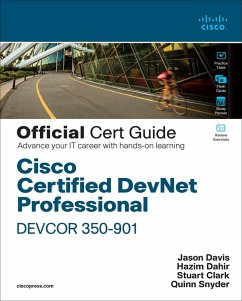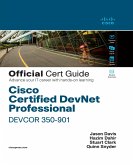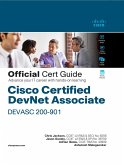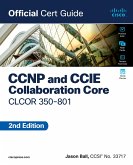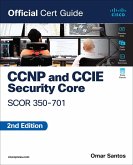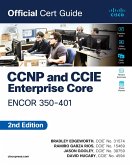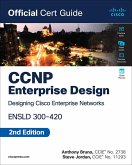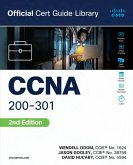Cisco Certified DevNet Professional DEVCOR 350-901 Official Cert Guide (eBook, ePUB)


Alle Infos zum eBook verschenken

Cisco Certified DevNet Professional DEVCOR 350-901 Official Cert Guide (eBook, ePUB)
- Format: ePub
- Merkliste
- Auf die Merkliste
- Bewerten Bewerten
- Teilen
- Produkt teilen
- Produkterinnerung
- Produkterinnerung

Hier können Sie sich einloggen

Bitte loggen Sie sich zunächst in Ihr Kundenkonto ein oder registrieren Sie sich bei bücher.de, um das eBook-Abo tolino select nutzen zu können.
Trust the best-selling Official Cert Guide series from Cisco Press to help you learn, prepare, and practice for exam success. They are built with the objective of providing assessment, review, and practice to help ensure you are fully prepared for your certification exam. * Understand and apply Cisco Certified DevNet Professional (DEVCOR 350-901) exam topics * Assess your knowledge with chapter-opening quizzes * Review key concepts with exam preparation tasks This is the eBook edition of the Cisco Certified DevNet Professional DEVCOR 350-901 Official Cert Guide. This eBook does not include…mehr
- Geräte: eReader
- ohne Kopierschutz
- eBook Hilfe
- Größe: 73.75MB
![Cisco Certified DevNet Professional DEVCOR 350-901 Official Cert Guide (eBook, PDF) Cisco Certified DevNet Professional DEVCOR 350-901 Official Cert Guide (eBook, PDF)]() Hazim DahirCisco Certified DevNet Professional DEVCOR 350-901 Official Cert Guide (eBook, PDF)38,95 €
Hazim DahirCisco Certified DevNet Professional DEVCOR 350-901 Official Cert Guide (eBook, PDF)38,95 €![Cisco Certified DevNet Associate DEVASC 200-901 Official Cert Guide (eBook, ePUB) Cisco Certified DevNet Associate DEVASC 200-901 Official Cert Guide (eBook, ePUB)]() Chris JacksonCisco Certified DevNet Associate DEVASC 200-901 Official Cert Guide (eBook, ePUB)27,95 €
Chris JacksonCisco Certified DevNet Associate DEVASC 200-901 Official Cert Guide (eBook, ePUB)27,95 €![CCNP and CCIE Collaboration Core CLCOR 350-801 Official Cert Guide (eBook, ePUB) CCNP and CCIE Collaboration Core CLCOR 350-801 Official Cert Guide (eBook, ePUB)]() Jason BallCCNP and CCIE Collaboration Core CLCOR 350-801 Official Cert Guide (eBook, ePUB)41,95 €
Jason BallCCNP and CCIE Collaboration Core CLCOR 350-801 Official Cert Guide (eBook, ePUB)41,95 €![CCNP and CCIE Security Core SCOR 350-701 Official Cert Guide (eBook, ePUB) CCNP and CCIE Security Core SCOR 350-701 Official Cert Guide (eBook, ePUB)]() Omar SantosCCNP and CCIE Security Core SCOR 350-701 Official Cert Guide (eBook, ePUB)36,95 €
Omar SantosCCNP and CCIE Security Core SCOR 350-701 Official Cert Guide (eBook, ePUB)36,95 €![CCNP and CCIE Enterprise Core ENCOR 350-401 Official Cert Guide (eBook, ePUB) CCNP and CCIE Enterprise Core ENCOR 350-401 Official Cert Guide (eBook, ePUB)]() Brad EdgeworthCCNP and CCIE Enterprise Core ENCOR 350-401 Official Cert Guide (eBook, ePUB)36,95 €
Brad EdgeworthCCNP and CCIE Enterprise Core ENCOR 350-401 Official Cert Guide (eBook, ePUB)36,95 €![CCNP Enterprise Design ENSLD 300-420 Official Cert Guide (eBook, ePUB) CCNP Enterprise Design ENSLD 300-420 Official Cert Guide (eBook, ePUB)]() Anthony BrunoCCNP Enterprise Design ENSLD 300-420 Official Cert Guide (eBook, ePUB)49,95 €
Anthony BrunoCCNP Enterprise Design ENSLD 300-420 Official Cert Guide (eBook, ePUB)49,95 €![CCNA 200-301 Official Cert Guide Library (eBook, ePUB) CCNA 200-301 Official Cert Guide Library (eBook, ePUB)]() Wendell OdomCCNA 200-301 Official Cert Guide Library (eBook, ePUB)44,95 €
Wendell OdomCCNA 200-301 Official Cert Guide Library (eBook, ePUB)44,95 €-
-
-
Dieser Download kann aus rechtlichen Gründen nur mit Rechnungsadresse in A, B, BG, CY, CZ, D, DK, EW, E, FIN, F, GR, HR, H, IRL, I, LT, L, LR, M, NL, PL, P, R, S, SLO, SK ausgeliefert werden.
- Produktdetails
- Verlag: Pearson ITP
- Seitenzahl: 752
- Altersempfehlung: ab 18 Jahre
- Erscheinungstermin: 15. August 2022
- Englisch
- ISBN-13: 9780137370429
- Artikelnr.: 66390836
- Verlag: Pearson ITP
- Seitenzahl: 752
- Altersempfehlung: ab 18 Jahre
- Erscheinungstermin: 15. August 2022
- Englisch
- ISBN-13: 9780137370429
- Artikelnr.: 66390836
- Herstellerkennzeichnung Die Herstellerinformationen sind derzeit nicht verfügbar.
Part I Software Development and Design
Chapter 1 Software Development Essentials 2
"Do I Know This Already?" Quiz 2
A Brief History of the Future 4
The Evolution 5
Automation, Orchestration, and DevOps 6
Software Architecture and Design 9
Architecture Requirements 10
Functional Requirements 13
Nonfunctional Requirements 13
Architectural Patterns 14
Software Development Lifecycle (SDLC) Approach 15
Software Development Models 17
Waterfall 17
Agile Software Development 18
Scrum 19
Extreme Programming 19
Kanban 19
Lean 19
Which Model? 20
Architecture and Code Reviews 21
Software Testing 22
Exam Preparation Tasks 23
Chapter 2 Software Quality Attributes 26
"Do I Know This Already?" Quiz 26
Foundation Topics 29
Quality Attributes and Nonfunctional Requirements 29
Brief Overview of the Most Common Quality Attributes 29
Measuring Quality Attributes 35
Modularity in Application Design 36
Benefits of Modularity 36
Modularity Coding Best Practices 37
Microservices and Modular Design 40
Scalability in Application Design 41
Horizontal Scalability 41
Vertical Scalability 42
Practical Scalability in Application Design 43
High Availability and Resiliency in Application Design 44
Failure or Fault Detection 46
Recovery: High Availability in Practice 47
Prevention 50
High Availability Planning and the Responsibilities of the Developer 50
High Availability Deployment Models 51
Exam Preparation Tasks 53
Chapter 3 Architectural Considerations and Performance Management 56
"Do I Know This Already?" Quiz 57
Foundation Topics 59
Maintainable Design and Implementation 59
Maintaining a SOLID Design 60
Single Responsibility Principle (SRP) 61
Open-Closed Principle (OCP) 62
Liskov's Substitution Principle (LSP) 63
Interface Segregation Principle (ISP) 64
Dependency Inversion Principle (DIP) 65
Latency and Rate Limiting in Application Design and Performance 66
Designing for Application Low Latency and High Performance 69
Architecture Trade-offs 69
Improving Performance 69
Design and Implementation for Observability 73
Logging 74
Metrics 76
Tracing 77
Good Documentation Practices: An Observability Reminder 78
Database Selection Criteria 79
Database Requirements Gathering 80
Data Volume 81
Data Velocity 82
Data Variety 82
Exam Preparation Tasks 83
Chapter 4 Version Control and Release Management with Git 86
"Do I Know This Already?" Quiz 86
Foundation Topics 88
Version Control and Git 88
Git Workflow 88
Branch and Pull Workflow 89
Pros 89
Cons 89
Sample Setup 90
Sample Branch and Pull Workflow 90
Fork and Pull Workflow 104
Pros 105
Cons 105
Sample Setup 105
Sample Fork and Pull Workflow 106
Git Branching Strategy 121
What Is a Branching Strategy? 121
The Most Important Factor When Selecting a Git Branching Strategy 122
Popular Git Branching Strategies 122
When to Use GitHub Flow 122
When to Use Git Flow 123
When to Use GitLab Flow 123
Recommended GitHub Settings 125
Configuring the PR Merge Button 125
Configuring a Branch Protection Rule to Require Code Reviews 125
Exam Preparation Tasks 127
Part II APIs
Chapter 5 Network APIs 130
"Do I Know This Already?" Quiz 130
Foundation Topics 132
What Are APIs? 132
Methods 133
Objects 134
Formats 134
APIs vs. No API 135
Web Scraping 135
Jeff Bezos's API Mandate: How the AWS API-Driven Cloud Was Born 136
Calling an API 138
What Is API Development? 144
API Architectural Styles 146
Selecting an API Style 147
HTTP/JSON 149
REST/JSON 150
Cache-Control 151
REST vs. RPC 152
gRPC 154
OpenAPI/Swagger 155
Network API Styles 157
NETCONF APIs 158
Exam Preparation Tasks 160
Chapter 6 API Development 162
"Do I Know This Already?" Quiz 163
Foundation Topics 165
Creating API Clients 165
Code Generation Client API Libraries for IMDb 165
Adding CLI Wrapper Code 174
Making Calls to IMDb Using a CLI Program 174
API Design Considerations 177
API Authentication Models 179
Flow Control (Pagination vs. Streaming) 181
Error Handling, Timeouts, and Rate Limiting 184
Caching 188
Exam Preparation Tasks 189
Part III Application Development, Deployment, and Security
Chapter 7 Application Deployment 192
"Do I Know This Already?" Quiz 193
Foundation Topics 194
The Evolution of Application Responsibilities 194
The Hybridization of Development and Operations 194
The Journey to DevOps 195
A Cultural Shift 196
The Emergence of the Site Reliability Engineer(ing) 196
SRE Responsibilities and Tenets 197
SRE vs. DevOps 198
Continuous Integration/Continuous Delivery (Deployment) 198
Continuous Integration (CI) 199
Continuous Delivery: One of the CDs 200
Continuous Deployment: The Other CD 200
CI/CD Pipeline Implementation 201
Pipeline Components 203
Build 204
Test 205
Release/Deliver 205
Deploy 205
Adding Deployment to Integration 207
Deploying to Infrastructure (Terraform + Atlantis) 207
Deploying Applications (Flux + Kubernetes) 213
Application Deployment Methods over Time 218
The 2000s: Sysadmins, Terminals, and SSH 218
The 2010s: Automated Configuration Management 220
The 2020s: The Clouds Never Looked So Bright 224
Managed Kubernetes (e.g., GKE) 224
Containers on Serverless Clouds (e.g., AWS ECS on Fargate) 227
Serverless Functions (e.g., AWS Lambda) 234
Software Practices for Operability: The 12-Factor App 238
Factor 1: Codebase 239
Factor 2: Dependencies 239
Factor 3: Config 239
Factor 4: Backing Services 240
Factor 5: Build, Release, Run 240
Factor 6: Processes 240
Factor 7: Port Binding 241
Factor 8: Concurrency 241
Factor 9: Disposability 241
Factor 10: Dev/Prod Parity 241
Factor 11: Logs 242
Factor 12: Admin Processes 242
Summary 243
Exam Preparation Tasks 243
Chapter 8 Security in Application Design 246
"Do I Know This Already?" Quiz 247
Foundation Topics 248
Protecting Privacy 250
Personally Identifiable Information 250
Data States 250
Laws, Regulations, and Standards for Protecting Privacy 251
Storing IT Secrets 252
Public Key Infrastructure (PKI) 254
Certificate Revocation 256
Hierarchical Multiple CA Infrastructure 257
TLS, PKI, and Web Applications Security 257
Browser Security Issues 261
Securing Web and Mobile Applications 262
Injection Attacks 263
Cross-Site Scripting 264
OAuth Authorization Framework 266
How Does OAuth Work? 266
OAuth 2.0 Two-Legged Authorization 268
OAuth 2.0 Three-Legged Authorization 269
Additional OAuth Authorization Code Grant Types 271
OAuth 2.0 Client Credentials 271
Resource Owner Password Credential Flow 272
OAuth 2.0 Implicit Flow 275
OAuth 2.0 Authorization Code Flow 276
OAuth 2.0 PKCE Flow 278
Refresh Token Flow 280
OAuth 2.0 Device Code Flow 281
Exam Preparation Tasks 283
Part IV Infrastructure and Automation
Chapter 9 Infrastructure 286
"Do I Know This Already?" Quiz 286
Foundation Topics 288
Network Management 288
Methods of Network Provisioning 290
CLI/Console 291
SNMP 294
File Transfer Methods 297
Element Management Systems 297
Embedded Management 299
Zero-Touch Provisioning (ZTP) 300
Atomic or SDN-Like/Controller-Based Networking 303
Advanced Concepts - Intent-Based Networking 305
Summary 307
Exam Preparation Tasks 307
Chapter 10 Automation 310
"Do I Know This Already?" Quiz 311
Foundation Topics 313
Challenges Being Addressed 313
Differences of Equipment and Functionality 314
Proximity of Management Tools and Support Staff 316
Speed of Service Provisioning 317
Accuracy of Service Provisioning 319
Scale 323
Doing More with Less 329
Software-Defined Networking (SDN) 329
What Is SDN and Network Programmability? 329
Approach 330
Nontraditional Entities 331
Industry Impact 331
New Methods 331
Normalization 332
Enabling Operations 332
Enabling Career Options 332
Use Cases and Problems Solved with SDN 332
Overview of Network Controllers 334
The Cisco Solutions 335
Application Programming Interfaces (APIs) 335
REST APIs 336
API Methods 337
API Authentication 337
API Pagination 337
Payload Data Formats JSON XML 338
XML 338
JSON 340
Cross-Domain, Technology-Agnostic Orchestration (CDTAO) 342
Impact to IT Service Management and Security 343
Exam Preparation Tasks 344
Chapter 11 NETCONF and RESTCONF 346
"Do I Know This Already?" Quiz 346
Foundation Topics 348
Catalyst for NETCONF 348
Content 349
Operations 350
Messages 350
Transport 351
Atomic and Model-Driven Configuration Management 351
How to Implement NETCONF 354
Enabling NETCONF on IOS XE 355
Enabling NETCONF on IOS XR 356
Enabling NETCONF on NX-OS 357
Basic Manual Use of NETCONF 358
YANG Models 365
The Evolution with RESTCONF 371
The RESTCONF Protocol Stack 372
RESTCONF Operations 372
RESTCONF and Authentication 373
RESTCONF URIs 373
Performing a RESTCONF GET Operation with cURL 375
Performing RESTCONF GET Operations with the Postman Utility 377
Management Solutions Using NETCONF and RESTCONF 382
Exam Preparation Tasks 383
Chapter 12 Model-Driven Telemetry 386
"Do I Know This Already?" Quiz 387
Foundation Topics 389
Transformation of Inventory, Status, Performance, and Fault Monitoring 389
Scaling with the Push Model 391
How to Implement Model-Driven Telemetry 393
Dial-In and Dial-Out Mode 395
Encoding (Serialization) 395
Protocols 396
Configuring MDT in IOS-XR 398
Configuring Dial-Out Mode 398
Step 1: Create a Destination Group 398
Step 2: Create a Sensor Group 400
Step 3: Create a Subscription 400
Step 4: Verify the Dial-Out Configuration 401
Configuring Dial-In Mode 402
Step 1: Enable gRPC 402
Step 2: Create a Sensor Group 404
Step 3: Create a Subscription 405
Step 4: Validate the Configuration 405
Picking Sensor Paths and Metrics 407
Researching Public Documentation 407
Extracting Model Support from the Device - NETCONF Manually 408
Extracting Model Support from the Device - Python and NETCONF 410
Digging into the YANG Models 414
Installing Docker to the Linux VM 414
Installing the YANG Suite Docker Image to the Linux VM 415
Practical Application of Streaming Telemetry 423
Using Telegraph, InfluxDB, and Grafana 426
Installing InfluxDB 426
Installing Telegraf 428
Beyond MDT: Event-Driven Telemetry 434
Other Considerations: Disk Usage 440
Frequency of Telemetry Push 441
Exam Preparation Tasks 441
Chapter 13 Open-Source Solutions 444
"Do I Know This Already?" Quiz 445
Foundation Topics 447
Infrastructure-as-Code (IaC) Concepts 447
Imperative and Declarative Models 448
Provisioning or Configuration Management 449
Differences Between Agent and Agentless Solutions 450
Agent-Based Solutions: Puppet and Chef 450
Agentless Solutions: Ansible and Terraform 474
Installing Ansible from the Package Manager 474
Installing the Latest Ansible from a Virtual Python Environment with pip
476
Configuring Ansible Inventory 481
Creating a Project-Level Inventory File 482
Creating an Ansible Playbook to Obtain show Command Results 483
Filtering, Templating, and Jinja2 487
Using Ansible to Modify Device Configurations 488
Terraform Overview 493
Installing Terraform 494
Using Terraform 496
Cisco Solutions Enabled for IaC 501
Exam Preparation Tasks 502
Chapter 14 Software Configuration Management 508
"Do I Know This Already?" Quiz 508
Foundation Topics 510
Software Configuration Management (SCM) 510
SCM Definitions and Standards 510
Why Do You Need SCM? 511
Which SCM Process Is Best for You? 512
Ansible 512
Terraform 515
Terraform or Ansible: A High-Level Comparison 518
Business and Technical Requirements 519
Architectural Decisions 519
Technical Debt 520
Exam Preparation Tasks 521
Chapter 15 Hosting an Application on a Network Device 524
"Do I Know This Already?" Quiz 524
Foundation Topics 527
Benefits of Edge Computing 527
Virtualization Technologies 527
Type-1 Hypervisors 528
Type-2 Hypervisors 528
Linux Containers (LXC) 529
Docker Containers 530
Application Container Ideas 532
Platforms Supporting Application Containers 533
How to Implement Application Containers 534
Validating Prerequisites 534
Enabling Application Hosting Framework 536
Using Cisco DNA Center for App Hosting 538
Using Cisco IOx Local Manager for App Hosting 547
Using the Command-Line Interface for App Hosting 553
Interacting with App Hosted iPerf3 556
Best Practices for Managing Application Containers 563
Exam Preparation Tasks 565
Part V Platforms
Chapter 16 Cisco Platforms 568
"Do I Know This Already?" Quiz 568
Foundation Topics 571
Webex 571
Enabling the Webex REST API/SDK Access 572
Webex API Documentation 573
API Examples 575
SDK Examples 577
Firepower 582
Enabling API/SDK Access to Firepower 582
Firepower API Documentation 583
Meraki 592
Enabling API/SDK Access to Meraki 592
Meraki API Documentation 593
Meraki SDK Documentation 594
Meraki Authorization 596
Intersight 601
Enabling API Access to Intersight 601
Intersight API Documentation 603
Intersight SDK Documentation 605
Intersight Authorization 606
UCS Manager 611
Enabling API Access to UCS Manager 611
UCS Manager API Documentation 611
Python SDK Documentation 617
PowerShell SDK Documentation 622
Additional UCS Manager Programmability Resources 628
DNA Center 628
Enabling API/SDK Access to DNA Center 630
DNA Center API Documentation 631
DNA Center SDK Documentation 635
SDK Authorization 637
AppDynamics 639
Exam Preparation Tasks 646
Chapter 17 Final Preparation 648
Getting Ready 648
Tools for Final Preparation 649
Pearson Cert Practice Test Engine and Questions on the Website 649
Accessing the Pearson Test Prep Software Online 649
Accessing the Pearson Test Prep Software Offline 649
Customizing Your Exams 650
Updating Your Exams 651
Premium Edition 651
Chapter-Ending Review Tools 652
Suggested Plan for Final Review/Study 652
Summary 652
Appendix A Answers to the "Do I Know This Already?" Questions 654
Appendix B Cisco DevNet Professional DEVCOR 350-901 Exam Updates 672
Glossary 675
Online Elements
Appendix C Memory Tables
Appendix D Memory Tables Answer Key
Appendix E Dashboard Basics
Glossary
Part I Software Development and Design
Chapter 1 Software Development Essentials 2
"Do I Know This Already?" Quiz 2
A Brief History of the Future 4
The Evolution 5
Automation, Orchestration, and DevOps 6
Software Architecture and Design 9
Architecture Requirements 10
Functional Requirements 13
Nonfunctional Requirements 13
Architectural Patterns 14
Software Development Lifecycle (SDLC) Approach 15
Software Development Models 17
Waterfall 17
Agile Software Development 18
Scrum 19
Extreme Programming 19
Kanban 19
Lean 19
Which Model? 20
Architecture and Code Reviews 21
Software Testing 22
Exam Preparation Tasks 23
Chapter 2 Software Quality Attributes 26
"Do I Know This Already?" Quiz 26
Foundation Topics 29
Quality Attributes and Nonfunctional Requirements 29
Brief Overview of the Most Common Quality Attributes 29
Measuring Quality Attributes 35
Modularity in Application Design 36
Benefits of Modularity 36
Modularity Coding Best Practices 37
Microservices and Modular Design 40
Scalability in Application Design 41
Horizontal Scalability 41
Vertical Scalability 42
Practical Scalability in Application Design 43
High Availability and Resiliency in Application Design 44
Failure or Fault Detection 46
Recovery: High Availability in Practice 47
Prevention 50
High Availability Planning and the Responsibilities of the Developer 50
High Availability Deployment Models 51
Exam Preparation Tasks 53
Chapter 3 Architectural Considerations and Performance Management 56
"Do I Know This Already?" Quiz 57
Foundation Topics 59
Maintainable Design and Implementation 59
Maintaining a SOLID Design 60
Single Responsibility Principle (SRP) 61
Open-Closed Principle (OCP) 62
Liskov's Substitution Principle (LSP) 63
Interface Segregation Principle (ISP) 64
Dependency Inversion Principle (DIP) 65
Latency and Rate Limiting in Application Design and Performance 66
Designing for Application Low Latency and High Performance 69
Architecture Trade-offs 69
Improving Performance 69
Design and Implementation for Observability 73
Logging 74
Metrics 76
Tracing 77
Good Documentation Practices: An Observability Reminder 78
Database Selection Criteria 79
Database Requirements Gathering 80
Data Volume 81
Data Velocity 82
Data Variety 82
Exam Preparation Tasks 83
Chapter 4 Version Control and Release Management with Git 86
"Do I Know This Already?" Quiz 86
Foundation Topics 88
Version Control and Git 88
Git Workflow 88
Branch and Pull Workflow 89
Pros 89
Cons 89
Sample Setup 90
Sample Branch and Pull Workflow 90
Fork and Pull Workflow 104
Pros 105
Cons 105
Sample Setup 105
Sample Fork and Pull Workflow 106
Git Branching Strategy 121
What Is a Branching Strategy? 121
The Most Important Factor When Selecting a Git Branching Strategy 122
Popular Git Branching Strategies 122
When to Use GitHub Flow 122
When to Use Git Flow 123
When to Use GitLab Flow 123
Recommended GitHub Settings 125
Configuring the PR Merge Button 125
Configuring a Branch Protection Rule to Require Code Reviews 125
Exam Preparation Tasks 127
Part II APIs
Chapter 5 Network APIs 130
"Do I Know This Already?" Quiz 130
Foundation Topics 132
What Are APIs? 132
Methods 133
Objects 134
Formats 134
APIs vs. No API 135
Web Scraping 135
Jeff Bezos's API Mandate: How the AWS API-Driven Cloud Was Born 136
Calling an API 138
What Is API Development? 144
API Architectural Styles 146
Selecting an API Style 147
HTTP/JSON 149
REST/JSON 150
Cache-Control 151
REST vs. RPC 152
gRPC 154
OpenAPI/Swagger 155
Network API Styles 157
NETCONF APIs 158
Exam Preparation Tasks 160
Chapter 6 API Development 162
"Do I Know This Already?" Quiz 163
Foundation Topics 165
Creating API Clients 165
Code Generation Client API Libraries for IMDb 165
Adding CLI Wrapper Code 174
Making Calls to IMDb Using a CLI Program 174
API Design Considerations 177
API Authentication Models 179
Flow Control (Pagination vs. Streaming) 181
Error Handling, Timeouts, and Rate Limiting 184
Caching 188
Exam Preparation Tasks 189
Part III Application Development, Deployment, and Security
Chapter 7 Application Deployment 192
"Do I Know This Already?" Quiz 193
Foundation Topics 194
The Evolution of Application Responsibilities 194
The Hybridization of Development and Operations 194
The Journey to DevOps 195
A Cultural Shift 196
The Emergence of the Site Reliability Engineer(ing) 196
SRE Responsibilities and Tenets 197
SRE vs. DevOps 198
Continuous Integration/Continuous Delivery (Deployment) 198
Continuous Integration (CI) 199
Continuous Delivery: One of the CDs 200
Continuous Deployment: The Other CD 200
CI/CD Pipeline Implementation 201
Pipeline Components 203
Build 204
Test 205
Release/Deliver 205
Deploy 205
Adding Deployment to Integration 207
Deploying to Infrastructure (Terraform + Atlantis) 207
Deploying Applications (Flux + Kubernetes) 213
Application Deployment Methods over Time 218
The 2000s: Sysadmins, Terminals, and SSH 218
The 2010s: Automated Configuration Management 220
The 2020s: The Clouds Never Looked So Bright 224
Managed Kubernetes (e.g., GKE) 224
Containers on Serverless Clouds (e.g., AWS ECS on Fargate) 227
Serverless Functions (e.g., AWS Lambda) 234
Software Practices for Operability: The 12-Factor App 238
Factor 1: Codebase 239
Factor 2: Dependencies 239
Factor 3: Config 239
Factor 4: Backing Services 240
Factor 5: Build, Release, Run 240
Factor 6: Processes 240
Factor 7: Port Binding 241
Factor 8: Concurrency 241
Factor 9: Disposability 241
Factor 10: Dev/Prod Parity 241
Factor 11: Logs 242
Factor 12: Admin Processes 242
Summary 243
Exam Preparation Tasks 243
Chapter 8 Security in Application Design 246
"Do I Know This Already?" Quiz 247
Foundation Topics 248
Protecting Privacy 250
Personally Identifiable Information 250
Data States 250
Laws, Regulations, and Standards for Protecting Privacy 251
Storing IT Secrets 252
Public Key Infrastructure (PKI) 254
Certificate Revocation 256
Hierarchical Multiple CA Infrastructure 257
TLS, PKI, and Web Applications Security 257
Browser Security Issues 261
Securing Web and Mobile Applications 262
Injection Attacks 263
Cross-Site Scripting 264
OAuth Authorization Framework 266
How Does OAuth Work? 266
OAuth 2.0 Two-Legged Authorization 268
OAuth 2.0 Three-Legged Authorization 269
Additional OAuth Authorization Code Grant Types 271
OAuth 2.0 Client Credentials 271
Resource Owner Password Credential Flow 272
OAuth 2.0 Implicit Flow 275
OAuth 2.0 Authorization Code Flow 276
OAuth 2.0 PKCE Flow 278
Refresh Token Flow 280
OAuth 2.0 Device Code Flow 281
Exam Preparation Tasks 283
Part IV Infrastructure and Automation
Chapter 9 Infrastructure 286
"Do I Know This Already?" Quiz 286
Foundation Topics 288
Network Management 288
Methods of Network Provisioning 290
CLI/Console 291
SNMP 294
File Transfer Methods 297
Element Management Systems 297
Embedded Management 299
Zero-Touch Provisioning (ZTP) 300
Atomic or SDN-Like/Controller-Based Networking 303
Advanced Concepts - Intent-Based Networking 305
Summary 307
Exam Preparation Tasks 307
Chapter 10 Automation 310
"Do I Know This Already?" Quiz 311
Foundation Topics 313
Challenges Being Addressed 313
Differences of Equipment and Functionality 314
Proximity of Management Tools and Support Staff 316
Speed of Service Provisioning 317
Accuracy of Service Provisioning 319
Scale 323
Doing More with Less 329
Software-Defined Networking (SDN) 329
What Is SDN and Network Programmability? 329
Approach 330
Nontraditional Entities 331
Industry Impact 331
New Methods 331
Normalization 332
Enabling Operations 332
Enabling Career Options 332
Use Cases and Problems Solved with SDN 332
Overview of Network Controllers 334
The Cisco Solutions 335
Application Programming Interfaces (APIs) 335
REST APIs 336
API Methods 337
API Authentication 337
API Pagination 337
Payload Data Formats JSON XML 338
XML 338
JSON 340
Cross-Domain, Technology-Agnostic Orchestration (CDTAO) 342
Impact to IT Service Management and Security 343
Exam Preparation Tasks 344
Chapter 11 NETCONF and RESTCONF 346
"Do I Know This Already?" Quiz 346
Foundation Topics 348
Catalyst for NETCONF 348
Content 349
Operations 350
Messages 350
Transport 351
Atomic and Model-Driven Configuration Management 351
How to Implement NETCONF 354
Enabling NETCONF on IOS XE 355
Enabling NETCONF on IOS XR 356
Enabling NETCONF on NX-OS 357
Basic Manual Use of NETCONF 358
YANG Models 365
The Evolution with RESTCONF 371
The RESTCONF Protocol Stack 372
RESTCONF Operations 372
RESTCONF and Authentication 373
RESTCONF URIs 373
Performing a RESTCONF GET Operation with cURL 375
Performing RESTCONF GET Operations with the Postman Utility 377
Management Solutions Using NETCONF and RESTCONF 382
Exam Preparation Tasks 383
Chapter 12 Model-Driven Telemetry 386
"Do I Know This Already?" Quiz 387
Foundation Topics 389
Transformation of Inventory, Status, Performance, and Fault Monitoring 389
Scaling with the Push Model 391
How to Implement Model-Driven Telemetry 393
Dial-In and Dial-Out Mode 395
Encoding (Serialization) 395
Protocols 396
Configuring MDT in IOS-XR 398
Configuring Dial-Out Mode 398
Step 1: Create a Destination Group 398
Step 2: Create a Sensor Group 400
Step 3: Create a Subscription 400
Step 4: Verify the Dial-Out Configuration 401
Configuring Dial-In Mode 402
Step 1: Enable gRPC 402
Step 2: Create a Sensor Group 404
Step 3: Create a Subscription 405
Step 4: Validate the Configuration 405
Picking Sensor Paths and Metrics 407
Researching Public Documentation 407
Extracting Model Support from the Device - NETCONF Manually 408
Extracting Model Support from the Device - Python and NETCONF 410
Digging into the YANG Models 414
Installing Docker to the Linux VM 414
Installing the YANG Suite Docker Image to the Linux VM 415
Practical Application of Streaming Telemetry 423
Using Telegraph, InfluxDB, and Grafana 426
Installing InfluxDB 426
Installing Telegraf 428
Beyond MDT: Event-Driven Telemetry 434
Other Considerations: Disk Usage 440
Frequency of Telemetry Push 441
Exam Preparation Tasks 441
Chapter 13 Open-Source Solutions 444
"Do I Know This Already?" Quiz 445
Foundation Topics 447
Infrastructure-as-Code (IaC) Concepts 447
Imperative and Declarative Models 448
Provisioning or Configuration Management 449
Differences Between Agent and Agentless Solutions 450
Agent-Based Solutions: Puppet and Chef 450
Agentless Solutions: Ansible and Terraform 474
Installing Ansible from the Package Manager 474
Installing the Latest Ansible from a Virtual Python Environment with pip
476
Configuring Ansible Inventory 481
Creating a Project-Level Inventory File 482
Creating an Ansible Playbook to Obtain show Command Results 483
Filtering, Templating, and Jinja2 487
Using Ansible to Modify Device Configurations 488
Terraform Overview 493
Installing Terraform 494
Using Terraform 496
Cisco Solutions Enabled for IaC 501
Exam Preparation Tasks 502
Chapter 14 Software Configuration Management 508
"Do I Know This Already?" Quiz 508
Foundation Topics 510
Software Configuration Management (SCM) 510
SCM Definitions and Standards 510
Why Do You Need SCM? 511
Which SCM Process Is Best for You? 512
Ansible 512
Terraform 515
Terraform or Ansible: A High-Level Comparison 518
Business and Technical Requirements 519
Architectural Decisions 519
Technical Debt 520
Exam Preparation Tasks 521
Chapter 15 Hosting an Application on a Network Device 524
"Do I Know This Already?" Quiz 524
Foundation Topics 527
Benefits of Edge Computing 527
Virtualization Technologies 527
Type-1 Hypervisors 528
Type-2 Hypervisors 528
Linux Containers (LXC) 529
Docker Containers 530
Application Container Ideas 532
Platforms Supporting Application Containers 533
How to Implement Application Containers 534
Validating Prerequisites 534
Enabling Application Hosting Framework 536
Using Cisco DNA Center for App Hosting 538
Using Cisco IOx Local Manager for App Hosting 547
Using the Command-Line Interface for App Hosting 553
Interacting with App Hosted iPerf3 556
Best Practices for Managing Application Containers 563
Exam Preparation Tasks 565
Part V Platforms
Chapter 16 Cisco Platforms 568
"Do I Know This Already?" Quiz 568
Foundation Topics 571
Webex 571
Enabling the Webex REST API/SDK Access 572
Webex API Documentation 573
API Examples 575
SDK Examples 577
Firepower 582
Enabling API/SDK Access to Firepower 582
Firepower API Documentation 583
Meraki 592
Enabling API/SDK Access to Meraki 592
Meraki API Documentation 593
Meraki SDK Documentation 594
Meraki Authorization 596
Intersight 601
Enabling API Access to Intersight 601
Intersight API Documentation 603
Intersight SDK Documentation 605
Intersight Authorization 606
UCS Manager 611
Enabling API Access to UCS Manager 611
UCS Manager API Documentation 611
Python SDK Documentation 617
PowerShell SDK Documentation 622
Additional UCS Manager Programmability Resources 628
DNA Center 628
Enabling API/SDK Access to DNA Center 630
DNA Center API Documentation 631
DNA Center SDK Documentation 635
SDK Authorization 637
AppDynamics 639
Exam Preparation Tasks 646
Chapter 17 Final Preparation 648
Getting Ready 648
Tools for Final Preparation 649
Pearson Cert Practice Test Engine and Questions on the Website 649
Accessing the Pearson Test Prep Software Online 649
Accessing the Pearson Test Prep Software Offline 649
Customizing Your Exams 650
Updating Your Exams 651
Premium Edition 651
Chapter-Ending Review Tools 652
Suggested Plan for Final Review/Study 652
Summary 652
Appendix A Answers to the "Do I Know This Already?" Questions 654
Appendix B Cisco DevNet Professional DEVCOR 350-901 Exam Updates 672
Glossary 675
Online Elements
Appendix C Memory Tables
Appendix D Memory Tables Answer Key
Appendix E Dashboard Basics
Glossary
